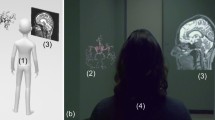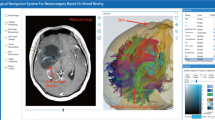Abstract
The treatment of hydrocephalus is based on anatomical landmarks to guide the insertion of an External Ventricular Drain (EVD). This procedure can benefit from the adoption of Mixed Reality (MR) technology. In this study, we assess the feasibility of a fully automatic MR and deep learning-based workflow to support emergency EVD placement, for which CT images are available and a fast and automatic workflow is needed. The proposed study provides a tool to automatically i) segment the skull, face skin, ventricles and Foramen of Monro from CT scans; ii) import the segmented model in the MR application; iii) register holograms on the patient’s head via a marker-less approach. An ad-hoc evaluation approach including 3D-printed anatomical structures was developed to quantitatively assess the accuracy and usability of the registration workflow.
M.C. Palumbo and S. Saitta—Equal first authorship.
Access this chapter
Tax calculation will be finalised at checkout
Purchases are for personal use only
Similar content being viewed by others
References
AlAzri, A., Mok, K., Chankowsky, J., Mullah, M., Marcoux, J.: Placement accuracy of external ventricular drain when comparing freehand insertion to neuronavigation guidance in severe traumatic brain injury. Acta Neurochir. 159(8), 1399–1411 (2017). https://doi.org/10.1007/s00701-017-3201-5
Arun, K.S., Huang, T.S., Blostein, S.D.: Least-squares fitting of two 3-D point sets. IEEE Trans. Pattern Anal. Mach. Intell. 5, 698–700 (1987)
Azimi, E., et al.: An interactive mixed reality platform for bedside surgical procedures. In: Martel, A.L., et al. (eds.) MICCAI 2020. LNCS, vol. 12263, pp. 65–75. Springer, Cham (2020). https://doi.org/10.1007/978-3-030-59716-0_7
Chen, Y., Medioni, G.: Object modelling by registration of multiple range images. Image Vis. Comput. 10(3), 145–155 (1992)
van Doormaal, J.A., Fick, T., Ali, M., Köllen, M., van der Kuijp, V., van Doormaal, T.P.: Fully automatic adaptive meshing based segmentation of the ventricular system for augmented reality visualization and navigation. World Neurosurg. 156, e9–e24 (2021)
Ester, M., et al.: A density-based algorithm for discovering clusters in large spatial databases with noise. In: Proceedings of the Second International Conference on Knowledge Discovery and Data Mining, vol. 96, pp. 226–231 (1996)
von Haxthausen, F., Chen, Y., Ernst, F.: Superimposing holograms on real world objects using Hololens 2 and its depth camera. Curr. Dir. Biomed. Eng. 7(1), 111–115 (2021)
Katz, S., Tal, A., Basri, R.: Direct visibility of point sets. ACM Trans. Graph. 26(3), 24-es (2007). https://doi.org/10.1145/1276377.1276407
Li, Y., et al.: A wearable mixed-reality holographic computer for guiding external ventricular drain insertion at the bedside. J. Neurosurg. 131(5), 1599–1606 (2018)
Mahan, M., Spetzler, R.F., Nakaji, P.: Electromagnetic stereotactic navigation for external ventricular drain placement in the intensive care unit. J. Clin. Neurosci. 20(12), 1718–1722 (2013)
Patrick, S., et al.: Comparison of gray values of cone-beam computed tomography with hounsfield units of multislice computed tomography: an in vitro study. Indian J. Dent. Res. 28(1), 66 (2017)
Saitta, S., et al.: A deep learning-based and fully automated pipeline for thoracic aorta geometric analysis and planning for endovascular repair from computed tomography. J. Digit. Imaging 35(2), 226–239 (2022)
Schneider, M., Kunz, C., Pal’a, A., Wirtz, C.R., Mathis-Ullrich, F., Hlaváč, M.: Augmented reality-assisted ventriculostomy. Neurosurg. Focus 50(1), E16 (2021)
Shen, Dinggang, Shen, D., et al. (eds.): MICCAI 2019. LNCS, vol. 11764. Springer, Cham (2019). https://doi.org/10.1007/978-3-030-32239-7
Ungureanu, D., et al.: Hololens 2 research mode as a tool for computer vision research. arXiv preprint arXiv:2008.11239 (2020)
Wilson, T.J., Stetler, W.R., Al-Holou, W.N., Sullivan, S.E.: Comparison of the accuracy of ventricular catheter placement using freehand placement, ultrasonic guidance, and stereotactic neuronavigation. J. Neurosurg. 119(1), 66–70 (2013)
Zhou, Q.-Y., Park, J., Koltun, V.: Fast global registration. In: Leibe, B., Matas, J., Sebe, N., Welling, M. (eds.) ECCV 2016. LNCS, vol. 9906, pp. 766–782. Springer, Cham (2016). https://doi.org/10.1007/978-3-319-46475-6_47
Zhou, Q.Y., Park, J., Koltun, V.: Open3D: a modern library for 3D data processing. arXiv preprint arXiv:1801.09847 (2018)
Author information
Authors and Affiliations
Corresponding author
Editor information
Editors and Affiliations
1 Electronic supplementary material
Below is the link to the electronic supplementary material.
Rights and permissions
Copyright information
© 2022 The Author(s), under exclusive license to Springer Nature Switzerland AG
About this paper
Cite this paper
Palumbo, M.C. et al. (2022). Mixed Reality and Deep Learning for External Ventricular Drainage Placement: A Fast and Automatic Workflow for Emergency Treatments. In: Wang, L., Dou, Q., Fletcher, P.T., Speidel, S., Li, S. (eds) Medical Image Computing and Computer Assisted Intervention – MICCAI 2022. MICCAI 2022. Lecture Notes in Computer Science, vol 13437. Springer, Cham. https://doi.org/10.1007/978-3-031-16449-1_15
Download citation
DOI: https://doi.org/10.1007/978-3-031-16449-1_15
Published:
Publisher Name: Springer, Cham
Print ISBN: 978-3-031-16448-4
Online ISBN: 978-3-031-16449-1
eBook Packages: Computer ScienceComputer Science (R0)





